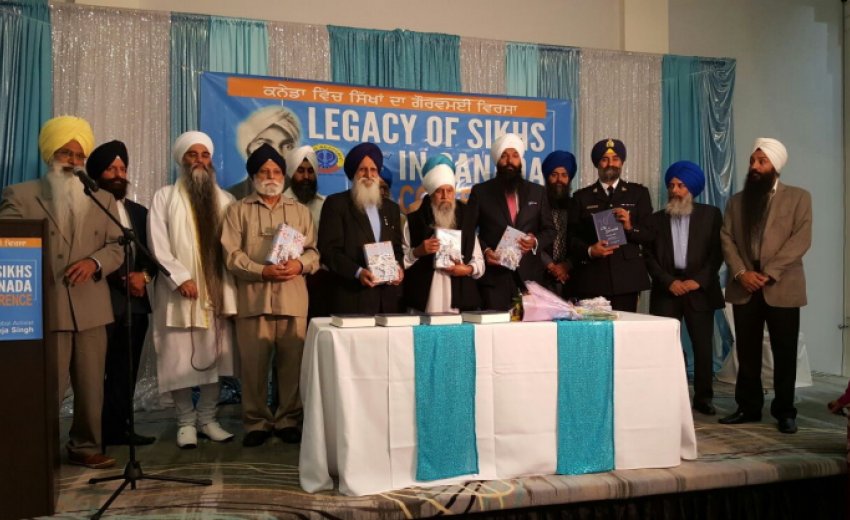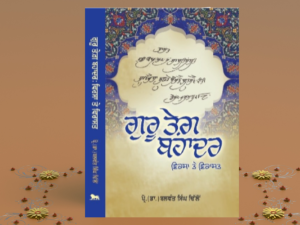Khalsa Diwan Society was established in 1906 in Vancouver through the efforts of the visionary Saint Scholar, Sant Teja Singh. The author, Dr. Khem Singh Gill, has made a tremendous effort to prepare this volume running into 59 Chapters covering the whole spectrum of life and services rendered by Sant Teja Singh to Sikh community globally. In the preface, author writes: "I had the privilege of kinship with Sant Teja Singh Ji since 1949 when I was a student of B.Sc. (Agriculture) at Khalsa College, Amritsar. I, therefore, have taken up the task of writing a biography in English of this highly educated, great Sikh scholar and Perfect Gur Sikh, Sant Teja Singh Ji." In my view, this kinship makes the author highly qualified to write this volume. In other words, a gurmukh is writing about another gurmukh. It is an uphill task to review this Volume of 767 pages; hence I took liberty to read salient features of this volume to make short shrift of my review.
Chapter 1 "Towards God consciousness" is rather too long for an introduction. The author has tried to elaborate sikhi concepts introduced in Sri Guru Granth Sahib (SGGS) by profusely quoting references from SGGS. In my view, author wanted to establish his thesis: Who is a Gurmukh? to justify the title of this volume. He has succeeded in his mission by juxtaposing the qualities of gurmukh vis a vis manmukh. Meditation on divine name and methods of meditation are elaborated (pp. 96-106), and Waheguru Gurmantra is recommended by the author on the basis of Gurbani. A critical examination of SGGS reveals that Waheguru Gurmantra is not recommended explicitly by any Guru author of Gurbani but by the scribe of SGGS, Bhai Gurdas, the great Sikh savant. The Bhat authors of Bani in SGGS use it explicitly but as a eulogy in praise of Sikh Gurus.
Sant Teja Singh was born on March 17, 1877 at village Bolowali, not far from my village Kamoke, district Gujranwala. Teja Singh was betrothed to Bishan Kaur while he was still an innocent looking middle school student. His father was a Doctor who could support his education even up to the University level. But his step mother proved to be a sore in his married life. Teja Singh passed his M.A. and LL.B. examinations in 1901 from Punjab University, Lahore. He had a brief stint as a practicing lawyer in Gujranwala; then served as Headmaster of a High School in Bhehra, before joining as an officer in North Indian Salt Department at Samber Lake, in present day Rajasthan. In 1904, Teja Singh moved to Khalsa College, Amritsar to enter his chosen vocation of teaching. Khalsa College proved to be a turning point in the life of Teja Singh, as the magnetic power of Gubani changed him from a materialist (atheist) to a seeker of spirituality. Thus Teja Singh underwent a profound spiritual experience during his service in Khalsa College. The author has described the ecstatic state of Teja Singh's mind overflowing with divine love. He was yearning to meet a divine person and ultimately succeeded in finding the most revered saint of India, Sant Attar Singh Ji of Mastuana.
The spiritual journey of Teja Singh started after he took Amrit from Panj Pyaras arranged by Sant Attar Singh Ji; he was reborn in the Khalsa fold and his name was changed from Niranjan Singh Mehta to Teja Singh under the command of Panj Pyaras. Teja Singh was a completely transformed personality, his association with saints like Baba Kesar Singh was motivating, who prophesied that Teja Singh will be blessed to visit England to spread Guru Nanak's message of Naam in the west. This prophesy came to be true when Teja Singh was mandated to visit England and America for higher studies and spreading the message of Sikh Gurus in those lands.
Education and Community Service: Teja Singh sailed for England on 6th August 1906 and joined University College London to obtain D.Sc. degree. After 2 months, he moved to Cambridge university and became the first turbaned Sikh on its campus. Mr Jackson, his tutor in the famous Downing College, allowed him the choice to keep his turban intact, against the rules of University, where black gown and cap were part of the dress code for both students and faculty. Teja Singh joined the degree for Science Tripos, started living in a rented accommodation with his family and performed the Parkash of Sri Guru Granth Sahib at his residence. He wanted to set up a Gurdwara in England and for this purpose he established Khalsa Jatha of the British Isles, London in 1908. The first Gurdwara in UK (and Europe) was started by Teja Singh in Shepherds Bush, West London. Teja Singh completed 5 terms out of 6; hence he fell short of the requirement to obtain Tripos degree at Cambridge. Leaving it midway, he moved on to USA to study for a PG degree at Teachers College, Columbia University, New York on July 5, 1908. He had a chequered career as a student and failed to finish his education in both Cambridge and Columbia University. Ultimately, he was allowed to join the Harvard University, USA, from where he took the Master's degree in School education in 1911 before his return to India.
Why Teja Singh failed to perform well in education? The author has tried to justify his failure due to circumstances prevailing at that time. Before he left, he was promised some financial help by Sant Attar Singh Ji, which never came through during his stay in England. He was living from hand to mouth most of his time with his family. Once or twice, he was reduced to a pauper with just 5 cents left on his person! But his faith in God and Guru helped him overcome such situations where survival looked remote. To pay high tuition fees, to support a family of 4 in a foreign country and to help his community in troubled waters was a herculean task which no one else except Teja Singh could do with grit and faith in God.
Sant Teja Singh was a good orator. He was invited to deliver lectures at Columbia University. His lectures created awareness about India and some Whites started learning Gurmat for their spiritual upliftment. His fame reached Canada and he was invited by Sikh Sangar of Vancouver for Gurmat Parchar. Teja Singh reached Vancouver on October 2, 1908 and participated in the activities of newly constructed Gurdwara. He visited Sikh community in Lower Midland and Port Moody during his one week's stay. He had to discontinue his studies at Columbia University for helping the Indian immigrants in getting PR (permanent residency) rights in Canada. Due to his social service for Indian community, he became an eye-sore in the imperial British circles; hence he was denied admission in Cambridge and Columbia University to complete his education.
Teja Singh was destined to play a sterling role in Canada to protect the rights of Indians. The Canadian Govt. had planned to settle all Indians in British Honduras and a committee was constituted to make plans for exporting Indians. Teja Singh had to fight on behalf of Indians a legal battle and delivered public awareness lectures to counteract the propaganda of Canadian government against Asians, particularly the Sikh immigrants of India. Attitudes of Whites in Canada were captured in a popular song:
For white man's land we fight,
To oriental grasp and greed
We shall surrender, no, never.
Our watchword be "God save the King",
White Canada for ever.
The Indians were not allowed to bring their families to Canada. To overcome this hurdle, the Sangar of Vancouver sent a telegram to Teja Singh on July 17, 1911. He convened a meeting of prominent Sikhs of Vancouver and a resolution was passed to send a deputation to Ottawa. This deputation consisted of 4 members: Teja Singh as its Leader, Dr Sundar Singh, Raja Singh and LW Hall, a missionary, as its members. This delegation met the concerned Ministers of Canadian Govt. and pleaded for removal of restrictions imposed on Indian immigrants to bring their families to Canada as British-Indian subjects. Teja Singh delivered public lectures in Ottawa to highlight this problem faced by Indians.
To help Mr. Crawford of New York, a devotee of Guru Nanak, to tide over his business crisis, Teja Singh registered a mining company "Guru Nanak Mining & Trust Company Limited" after purchasing 25% shares of Jacksonville gold mining company of California. He wanted to establish that Sikh immigrants are not poor and a burden on Canadian society, rather they can create jobs and bring business to Canada. Teja Singh was so successful in his exhortations in favour of Indians that he was considered a Mahatma and recognized as uncrowned King of the East Indians in British Columbia. He was instrumental in registering Khalsa Diwan Society, Vancouver on March 13, 1909 under the Society Act of BC, Canada. This Society is still active in Vancouver for promotion of sikhism in Canada. It was a morale booster not only for the Sikhs but also for other Indian groups. Professor Teja Singh acted as the Head Priest and selected Panj Pyaras for Amrit Sanchar in British Columbia. This group was invited to UK for the same purpose and it left Vancouver to propagate Sikh religion.
However, as the divine message in Gurbani ordains: "Adversity is a medicine whereas prosperity leads to maladies; for, where there is pleasure, there is no desire for God (dukh daaroo sukh rog bha-i-aa jaa sukh taam na ho-ee)". The English poet, Oliver Goldsmith, also exhorts in a similar vein in his poem "Deserted Village":
Ill fares the land, to hastening ills a prey,
Where wealth accumulates, and men decay.
When the Sikhs started bathing in the prosperity, there was a split and the opponents of Teja Singh wanted to implicate him in a case of embezzlement of company funds. He was called back from London and when the audit was done the charge of bungling proved to be false. The shares of gold mine were surrendered to Mr Crawford and the dream of Teja Singh to establish a Sikh University in Vancouver remained a far cry.
Teja Singh presented his paper "The Sikh Movement in India and its relation to Free Christianity" to highlight the contributions of Sikh Gurus in a Berlin Congress of Free Christianity held on 5-11 August, 1910. After completing his Masters degree in Harvard, he moved to California on the invitation of Baba Jawala Singh and Baba Wasakha Singh (Gadari Babas) of Holtville Farm and first Sikh Gurdwara in USA was founded in Sept. 1911 at Stockton. The Pacific Coast Khalsa Diwan Society, Stockton was registered on 27 May, 1912 to avoid any legal troubles. Teja Singh was elected as its first President. I happened to visit Sikh Museum at Stockton and found that Sikh Sangar (congregation) was allowed to sit on chairs as in a Church, while Guru Granth Sahib was installed on a podium. Before his return to India, a new Gurdwara was established in Victoria, BC, Canada on 6 October, 1912.
Teja Singh boarded the ship Mont-eagle at Vancouver towards the end of March 1913 and journeyed back to India via Japan, China, Hong Kong, Singapore and Malaya. He faced lot of hardships, for example, he boarded the ship from Kobe (Japan) without tickets for his family, but his faith in Guru was unshakable. Before he disembarked at Shanghai, a procession of 35,000 Sikhs was waiting for his reception at the port and they paid for his journey. He was overwhelmed by the welcome received from the Sikh Sangars of China, Hong Kong and elsewhere, who offered him gifts and paid for his journey onwards to India. Teja Singh delivered lectures, organised Keertan samagams and held Amrit Sanchar programs in Gurdwaras. It shows sikhi was flourishing in South-East Asia before his arrival and he became an instrument to further boost it. He returned to the holy presence of Sant Attar Singh Ji at Mastuana Sahib after almost 7 years to receive his blessings.
Sant Teja Singh as an Institution Builder and Preacher: Teja Singh was subjected to rigorous spiritual training by Sant Attar Singh Ji. His daily routine started at 2 AM in the ambrosial hour (Amrit vela), joining religious services till sun rise and then doing manual work (Seva) as ordained by the Master. After 3 years (1913-16) of training and passing rigorous tests, he was allowed to serve the Society in the field of education. His first assignment was as Principal, Khalsa Girls High School, Bhasaur set up by Babu Teja Singh, a Sikh reformer. He resigned from Bhasaur and joined Khalsa High School, Kallar (Dera Khalsa). On the bidding of his Master (Sant Attar Singh), he joined as Founder Principal of Guru Nanak Khalsa College, Gujranwala (1917); laid the foundation stone of Akal College at Mastuana (1918), and then joined as Principal, Teachers Training College, Banaras Hindu University (BHU) (1919), the premier institution of India. It may be of interest to readers of the Sikh Review that foundation stone of BHU was laid by Sant Attar Singh Ji on 24 December, 1914. After a year of stay in BHU, Teja Singh was called back to Mastuana in 1920 by his Master to run the Akal College. He arranged donations for the college building in Calcutta and mortgaged his own house in Gujranwala to raise funds. Such was his devotion and dedication for the cause of rural education in Punjab. He served as Principal, Akal College for 3 years and when group jealousy raised its head, Teja Singh went back to Guru Nanak Khalsa College Gujranwala as its Principal (1923). He resigned in 1926 to join his Master on a spiritual mission for life.
Sant Teja Singh remained attached to Sant Attar Singh Ji as a devoted comrade on his missionary tours in Kashmir and Punjab. He was engaged in the spiritual uplift of Sikhs and other communities in Punjab as advised by his Master. When the Master left his mortal frame, Teja Singh raised Gurdwaras at Cheema (Sangrur) and Tapiana Sahib, Kanoha (now Pakistan) in his memory. Sant Teja Singh undertook extensive missionary travels to East Africa, Burma, Thailand, Singapore, Malaya, Japan, USA and Canada to preach and promote the mission of Sikh Gurus. Finally, Sant Teja Singh moved to the scenic valley of Himalayas and built the first mud Gurdwara at Baru Sahib (Solan, HP) in 1960. I has now grown as the hub of Akal Academies throughout India under the Kalgidhar Trust registered in 1982 at Simla. The ideal of Sant Teja Singh and his Master to provide value-based education has been put into practice at Baru Sahib by Baba Iqbal Singh, the patron of Akal Academies, and the author of this book, Dr Khem Singh Gill.
It may be pointed out that I have to leave many episodes untouched in the life of Sant Teja Singh and his Master (Sant Attar Singh Ji). For example, Sant Teja Singh was a Gurmukh saint-scholar par excellence but was not a social recluse, like our traditional Indian Rishi-munis. He was fully conscious of his responsibilities towards his community. He was involved in Gurdwara Reform Movement during 1920s. He was so much respected in Sikh community that he was chosen as first interim Jathedar of Akal Takhat, a fact unknown to many Sikh historians. But it was not of his ilk to join Sikh politics of Gurdwaras.
I congratulate the author for his labour of love. It must have taken years of strenuous research to dig up scattered archival materials. Despite all efforts by the author, some minor mistakes and howlers may be pointed out as follows: some Gurbani quotes have a mismatch with the text (page 37); corrections in Gurbani quotes required in footnotes (pages 71 & 85); tell-tale information about Baba Banda Singh's martyrdom is not trust-worthy (page 223); information about second Sikh war happening in 1819 is wrong (page 268); Boon (Bonn?) university in Germany (page 321), and some minor typos which need to be corrected.






